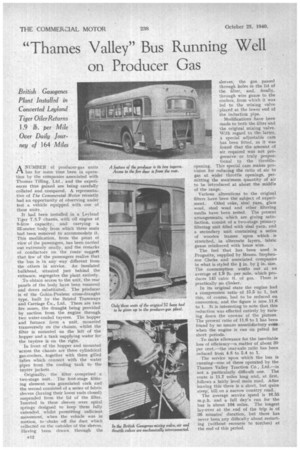"Thames Valley" Bus Running Well on Producer Gas
Page 30

If you've noticed an error in this article please click here to report it so we can fix it.
ANUMBER of producer-gas units has for some time been in operation by the companies associated with
Thomas Tilling, Ltd., and the experiences thus gained are being carefully
collated and compared. A representative of The Commercial Motor recently had an opportunity of observing under test a vehicle equipped with one of these units.
It had been installed in a Leyland Tiger T.S.7 chassis, with oil engine of 8-litre capacity, and carrying a 32-seater body from which three seats had been removed to accommodate it. This modification, from the point of view of the passengers, has been carried out extremely neatly, and the remarks of conductors on the route suggett that few of the passengers realize that the bus is in any way different from the others in service. An insulated bulkhead, situated just behind the entrance, segregates the plant entirely.
To obtain access to the unit, the rear panels of the body have been removed and doors substituted. The producer is of the Gohin-Poulenc cross-draught type, built by the Bristol Tramways and Carriage Co., Ltd. There are two fire zones, the draught being provided by suction from the engine through two water-cooled tuyeres. The hopper and furnace form a unit, mounted transversely on the chassis, whilst the filter is mounted on the left of the hopper and a tank supplying water for the tuyeres is on the right.
In front of the hopper and mounted 'across the chassis are three cylindrical as-coolers, together with three gilled tubes which connect with the water pipes from the cooling tank to the tuyere jackets.
Originally, the filter comprised a two-stage unit. The first-stage filtering element was granulated cork and the second consisted of a series of fabric sleeves (having their lower ends closed) suspended from the lid of the filter, Inserted in these sleeves were spiral springs designed to keep them fully extended, whilst permitting sufficient movement, when the vehicle was in motion, to -shake off the dust which collected on the outsides of the sleeves. Having been drawn through the sleeves, the gas passed through holes in the lid of the filter, and, finally, through wire gauze to the coolers, from which it was led to the mixing valve ' placed at the lower end of the induction pipe.
Modifications have been made to both the filter and the original mixing valve. With regard to the latter, a special adjustable cam has been fitted, as it was found that the amount of air required was not progressive or truly proportional to the throttleopening. This special cam makes provision for reducing the ratio of air to gas at wider throttle openings, permitting the maximum quantity of air to be introduced at about the middle of the range..
Various alterations to the original filters have been the subject of experi ment. Oiled coke, sisal yarn, glass wool, steel wool and other filtering
• media have been tested. The present arrangements, which are giving satisfaction, consist of a two-stage primary filtering unit filled with sisal yarn, and a secondary unit containing a series of wooden frames upon which is stretched, in alternate layers, fabric gauze reinforced with brass wire.
The fuel that has been used is Progasite, supplied by Messrs. Stephenson Clarke and associated companies in what is styled the .1 in. by in. size. The consumption works out at an average of 19 lb. per mile, which produces 143 cubic ft. of gas. There is practically no clinker.
In its original state the engine had a compression ratio of 15.5 to 1, but this, of course, had to be reduced on conversion, and the figure is now 11.6 to 1. It is interesting to note that this reduction was effected entirely by turning down the crowns of the pistons. The present ratio of 11.6 to 1 has been found by no means unsatisiactory evert when the engine is run on petrol for short periods.
To make allowance for the inevitable loss of efficiency—a matter of about 30 per cent.—the rear-axle ratio has been reduced from 4.8 to 5.4 to 1.
The service upon which the bus is running—one of those operated by the Thames Valley Traction Co„ Ltd.—is not a particularly difficult one. The route is 11.7 miles long and, at first, follows a fairly level main road. After leaving this there is a short, but quite steep; hill on a narrow country road.
The average service speed is 16.55 m.p.h. and a full day's run for the bus is about 164 miles. The longest lay-over at the .end of the trip is of 36 minutes' duration, but there has never been any difficulty about restarting (without recourse to torches) at the end of this period.




















































